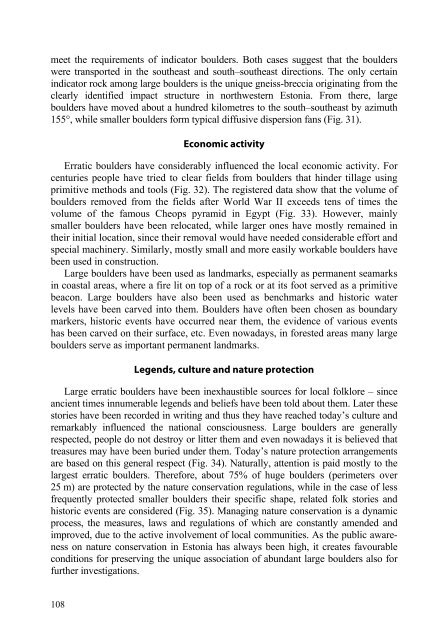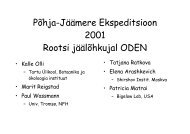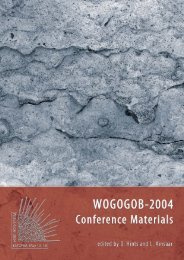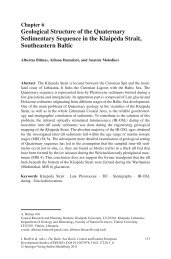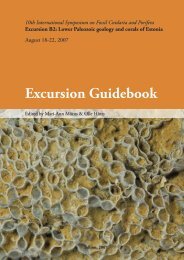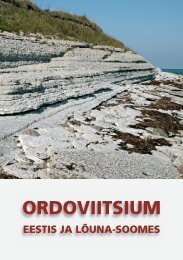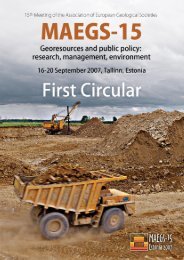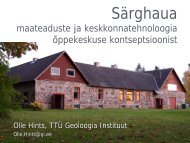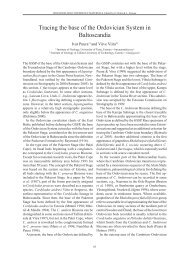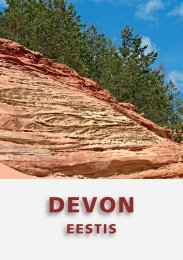meet the requirements of indicator boulders. Both cases suggest that the boulderswere transported in the southeast and south–southeast directions. The only certainindicator rock among large boulders is the unique gneiss-breccia originating from theclearly identified impact structure in northwestern Estonia. From there, largeboulders have moved about a hundred kilometres to the south–southeast by azimuth155°, while smaller boulders form typical diffusive dispersion fans (Fig. 31).Economic activityErratic boulders have considerably influenced the local economic activity. Forcenturies people have tried to clear fields from boulders that hinder tillage usingprimitive methods and tools (Fig. 32). The registered data show that the volume ofboulders removed from the fields after World War II exceeds tens of times thevolume of the famous Cheops pyramid in Egypt (Fig. 33). However, mainlysmaller boulders have been relocated, while larger ones have mostly remained intheir initial location, since their removal would have needed considerable effort andspecial machinery. Similarly, mostly small and more easily workable boulders havebeen used in construction.Large boulders have been used as landmarks, especially as permanent seamarksin coastal areas, where a fire lit on top of a rock or at its foot served as a primitivebeacon. Large boulders have also been used as benchmarks and historic waterlevels have been carved into them. Boulders have often been chosen as boundarymarkers, historic events have occurred near them, the evidence of various eventshas been carved on their surface, etc. Even nowadays, in forested areas many largeboulders serve as important permanent landmarks.Legends, culture and nature protectionLarge erratic boulders have been inexhaustible sources for local folklore – sinceancient times innumerable legends and beliefs have been told about them. Later thesestories have been recorded in writing and thus they have reached today’s culture andremarkably influenced the national consciousness. Large boulders are generallyrespected, people do not destroy or litter them and even nowadays it is believed thattreasures may have been buried under them. Today’s nature protection arrangementsare based on this general respect (Fig. 34). Naturally, attention is paid mostly to thelargest erratic boulders. Therefore, about 75% of huge boulders (perimeters over25 m) are protected by the nature conservation regulations, while in the case of lessfrequently protected smaller boulders their specific shape, related folk stories andhistoric events are considered (Fig. 35). Managing nature conservation is a dynamicprocess, the measures, laws and regulations of which are constantly amended andimproved, due to the active involvement of local communities. As the public awarenesson nature conservation in Estonia has always been high, it creates favourableconditions for preserving the unique association of abundant large boulders also forfurther investigations.108
LISADLisa 1Hiidrahnud EestisPikkus Laius Kõrgus Ümberm. Maht, m 3 KivimTallinnKuradisadul (Nurmiku t) 11,3 5,9 3,1 28,4 RabakiviMerivälja hiidrahn 10,0 5,8 3,0 26,4 GneissMänniku hiidrahn 11,9 9,5 5,7 34,4 238 RabakiviRahumäe hiidrahn 10,7 4,5 4,2 27,8 “Harjumaa I (saared)Lemmikneeme I Aegna 8,7 8,0 2,5 26,8 “Lemmikneeme II “ 10,0 8,1 3,3 27,9 “Lemmikneeme III “ 12,5 8,4 3,6 35,1 “Põlendikukivi Naissaar 10,6 7,4 7,0 28,8 “Lehtmetsa kivi “ 10,3 7,4 3,3 30,8 “Punane kivi Prangli 11,1 8,8 2,8 31,1 “Harjumaa II (mandriosa)Algaja kivi 10.1 6,4 2,7 29,1 GneissAruküla hiidrahn 14,2 8,4 6,2 34.4 3<strong>60</strong> RabakiviAugu Suurkivi 10,5 7,2 6,9 28,3 “Ellandvahe rahn 12,0 8,9 5,9 31,3 332 “Hansumäe rahn 10,2 7,8 4,5 31,2 200 “Hara Suurkivi 11,0 6,9 4,5 29,4 ApliitgraniitJaani-Mardi Suurkivi 13,2 9,2 5,7 34,5 288 SilmisgraniitJaani-Tooma Suurkivi 11,8 8,6 7,5 27,6 274 RabakiviJaanukse kultusekivi 10,9 7,4 2,6 28,8 “Kabelikivi 19,3 14,9 6,4 58,0 728 “Kakukivi = Saunakivi 9,3 9,0 4,6 28,5 PegmatiitKandukivi 10.0 5,8 2,9 27,7 RabakiviKiviheinamaa kivi 10,6 6,5 5,4 28,2 “Kurkse Kaarnavälja Liukivi 11,1 8,4 2,6 27,9 “Kupu kivi 12,5 8,7 5,8 33,2 238 PegmatiitKõrendakivi 11,7 6,2 3.2 30,8 RabakiviLaulumäe kivi 16,3 13,7 4,5 43,7 317 “Leetse Lodukivi (Sarapuu r.) 10,3 5,1 4,0 24,8 “Leetse mõisa rahnudekogumI Kaheosaline 19,6 ~6 2–3 ~55 “II Kruusaalune 11.0 8,6 1,8 29,8 “III Korrapäratu 2,4 29,4 “Luubakivi 10,1 7,9 4,1 26,4 “Maisiniidi kivi 12,1 9,7 6,6 33,1 397 “Majakivi 15,1 11,0 7,0 40,9 584 MigmatiitMardimiku kivi 9,2 8,1 4,3 27,3 RabakiviPainuva kivi 12,2 11,0 5,2 34,1 340 “Pakri Neosti hiidrahn 11,2 5,2 5,0 28,0 “Pärnamäe hiidrahn 12,7 9,2 5,8 31,1 284 “Suurupi ranna hiidrahn 10,4 4,8 2,6 26,4 “Taari rahn 13,6 9,8 5,8 34,9 264 “Tammispea I 10.2 7,1 3,9 29,2 120 “109
- Page 1:
ENN PIRRUSEESTIMAASUURED KIVIDSuurt
- Page 4 and 5:
Toimetanud: Aasa AaloeKeeletoimetaj
- Page 8:
kõik ettejäänu, kündis üles pu
- Page 14 and 15:
andmebaasi jaoks põhiplaan ja joon
- Page 16 and 17:
SUURTE RAHNUDE ÜLDISELOOMUSTUSSuur
- Page 18 and 19:
Teada on Osmussaare Kaksikute purus
- Page 20 and 21:
Niisiis on suurte rändrahnude seas
- Page 22 and 23:
tegevuses. On ju rahnude teisaldami
- Page 24 and 25:
A-BA-DB70,060,01200,01000,050,0800,
- Page 26 and 27:
palju, saame tulemi, mis toetub kü
- Page 28 and 29:
0 10 20 30 40%IIIIIIIVVVIVIIVIIIHii
- Page 30 and 31:
kergemini lõhederikkad ja jämedat
- Page 32 and 33:
tel (Pakri poolsaarel Neostis ja P
- Page 34 and 35:
et tegemist pole inimese katsega sa
- Page 36 and 37:
Pakril, Vana-Jüri rahnud Käsmus,
- Page 38 and 39:
1 2 34 5Joonis 11. Iseloomulike kiv
- Page 40 and 41:
entusiasm. Nii on Rooni järvedest
- Page 43:
Mõlemad ettevõtmised jäid suure
- Page 47 and 48:
RAHNUDE LEVIKSuurte rahnude pindala
- Page 49 and 50:
Tallinna ümbrusHARJUMAATallinna ü
- Page 52 and 53:
55%75%Joonis 19. Hiidrahnudele läh
- Page 54 and 55:
RAHNUDE KIVIMILINE KOOSTISEestisse
- Page 56 and 57:
tega kaetud aladele, kus nad lõpuk
- Page 58 and 59:
RabakividSee graniidierim on Eesti
- Page 60 and 61: Tuleb aga märkida, et mitte kõik
- Page 62 and 63: Eriteralistele graniitidele on isel
- Page 64 and 65: suurte ühesuunaliste rõhkude alla
- Page 66 and 67: Teised kivimitüübidLoetletud kivi
- Page 68 and 69: sadamasse, Salajõe kaksikrahnuna L
- Page 70 and 71: Rahnude ümbermõõt> 25 m96 rahnu
- Page 72 and 73: Rahnude ümbermõõt> 20 m223 rahnu
- Page 74 and 75: lähtealasid ja neist laiali hajuva
- Page 76 and 77: 22°E23°ES o o m e l a h t24°ENEU
- Page 78 and 79: Kiviveokelk.Kivi tõstmine reele.Ki
- Page 80 and 81: nende lõhenemis- ja murenemisilmin
- Page 82 and 83: umine lausa möödapääsmatu. Kind
- Page 84 and 85: Paljud neist on üldsusele küll tu
- Page 86 and 87: suurte kividega. Esimesed rahvaloom
- Page 88 and 89: kivile kogunenud vesi või asetatud
- Page 90 and 91: RAHNUDE KAITSEEeltoodust nähtub se
- Page 92 and 93: lääneranna rahn, Valingu kivi ja
- Page 94 and 95: Rahnud ja kivikülvid4258 16 827382
- Page 96 and 97: LÕPETUSEKSHeidetud pilk Eestimaad
- Page 98 and 99: Hermann, U. 1973. Mustvee piirikivi
- Page 100: Linkrus, E. 2000. E. Russow ja Käs
- Page 104 and 105: LARGE ERRATIC BOULDERS OF ESTONIASu
- Page 106 and 107: absent (1.7-4.3%, Table 4). The lat
- Page 108 and 109: types (many rapakivi boulders) and
- Page 112 and 113: Pikkus Laius Kõrgus Ümberm. Maht,
- Page 114 and 115: Hiidrahnude lähedased rahnud (ümb
- Page 116 and 117: Pikkus Laius Kõrgus Ümberm. Maht,
- Page 118 and 119: Pikkus Laius Kõrgus Ümberm. Maht,
- Page 120 and 121: Pikkus Laius Kõrgus Ümberm., erip
- Page 122 and 123: Pikkus Laius Kõrgus Ümberm., erip
- Page 124 and 125: Eesti suuremaid hiidrahne3. Majakiv
- Page 126 and 127: Eesti suuremaid hiidrahne7. Ellandv
- Page 128 and 129: Vähem tuntud hiidrahne11. Taari hi
- Page 130 and 131: Vähem tuntud hiidrahne15. Meriväl
- Page 132 and 133: Vähem tuntud hiidrahne19. Kõrenda
- Page 134 and 135: Vähem tuntud hiidrahne23. Ellukivi
- Page 136 and 137: Hiljuti avastatud hiidrahne vähe k
- Page 138 and 139: Hiidrahnudele lähedasi suuri kive3
- Page 140 and 141: Hiidrahnudele lähedasi suuri kive3
- Page 142 and 143: Rahnude lasumus39. Suuri rahne tule
- Page 144 and 145: Rüsijää surub rahne mõnikord p
- Page 146 and 147: Rahnud teetrassidel47. Kuningakivi
- Page 148 and 149: Rahnud koduaias51. Merivälja Suurk
- Page 150 and 151: Suured kivid rahvapärimustes55. Sa
- Page 152 and 153: Suured kivid rahvapärimustes59. Ra
- Page 154 and 155: Rahnukogumid63. Suured rahnud puden
- Page 156 and 157: Kivikülvid67. Kivirikkast moreenis
- Page 158 and 159: Tehiskuhjed71. Oti ehk Põlise Lepp
- Page 160 and 161:
Rändrahnude sagedasemad kivimid75.
- Page 162 and 163:
Rändrahnude kivimeid kivimeid lihv
- Page 164 and 165:
Rahnude purustamine ja hävimine82.
- Page 166 and 167:
Rahnud ehitusmaterjalina86. Tardkiv
- Page 168 and 169:
Rahnud ehitusmaterjalina90. Harva o
- Page 170:
Pilk päritolumaale. Siit nad saabu


